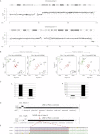Nonallelic homologous recombination between retrotransposable elements is a driver of de novo unbalanced translocations
- PMID: 23212949
- PMCID: PMC3589530
- DOI: 10.1101/gr.145631.112
Nonallelic homologous recombination between retrotransposable elements is a driver of de novo unbalanced translocations
Abstract
Large-scale analysis of balanced chromosomal translocation breakpoints has shown nonhomologous end joining and microhomology-mediated repair to be the main drivers of interchromosomal structural aberrations. Breakpoint sequences of de novo unbalanced translocations have not yet been investigated systematically. We analyzed 12 de novo unbalanced translocations and mapped the breakpoints in nine. Surprisingly, in contrast to balanced translocations, we identify nonallelic homologous recombination (NAHR) between (retro)transposable elements and especially long interspersed elements (LINEs) as the main mutational mechanism. This finding shows yet another involvement of (retro)transposons in genomic rearrangements and exposes a profoundly different mutational mechanism compared with balanced chromosomal translocations. Furthermore, we show the existence of compound maternal/paternal derivative chromosomes, reinforcing the hypothesis that human cleavage stage embryogenesis is a cradle of chromosomal rearrangements.
Figures


Similar articles
-
Unbalanced translocations arise from diverse mutational mechanisms including chromothripsis.Genome Res. 2015 Jul;25(7):937-47. doi: 10.1101/gr.191247.115. Epub 2015 Jun 12. Genome Res. 2015. PMID: 26070663 Free PMC article.
-
Whole-Genome Sequencing of Cytogenetically Balanced Chromosome Translocations Identifies Potentially Pathological Gene Disruptions and Highlights the Importance of Microhomology in the Mechanism of Formation.Hum Mutat. 2017 Feb;38(2):180-192. doi: 10.1002/humu.23146. Epub 2016 Dec 5. Hum Mutat. 2017. PMID: 27862604 Free PMC article.
-
Observation and prediction of recurrent human translocations mediated by NAHR between nonhomologous chromosomes.Genome Res. 2011 Jan;21(1):33-46. doi: 10.1101/gr.111609.110. Genome Res. 2011. PMID: 21205869 Free PMC article.
-
Chromatin structural elements and chromosomal translocations in leukemia.DNA Repair (Amst). 2006 Sep 8;5(9-10):1282-97. doi: 10.1016/j.dnarep.2006.05.020. Epub 2006 Aug 7. DNA Repair (Amst). 2006. PMID: 16893685 Review.
-
Historical and Clinical Perspectives on Chromosomal Translocations.Adv Exp Med Biol. 2018;1044:1-14. doi: 10.1007/978-981-13-0593-1_1. Adv Exp Med Biol. 2018. PMID: 29956287 Review.
Cited by
-
De novo mutations, genetic mosaicism and human disease.Front Genet. 2022 Sep 26;13:983668. doi: 10.3389/fgene.2022.983668. eCollection 2022. Front Genet. 2022. PMID: 36226191 Free PMC article. Review.
-
De novo unbalanced translocations have a complex history/aetiology.Hum Genet. 2018 Oct;137(10):817-829. doi: 10.1007/s00439-018-1941-9. Epub 2018 Oct 1. Hum Genet. 2018. PMID: 30276538 Clinical Trial.
-
Engineering a wild-type diploid Saccharomyces cerevisiae strain for second-generation bioethanol production.Bioresour Bioprocess. 2016;3(1):51. doi: 10.1186/s40643-016-0126-4. Epub 2016 Nov 24. Bioresour Bioprocess. 2016. PMID: 27942436 Free PMC article.
-
Plant genome evolution in the genus Eucalyptus is driven by structural rearrangements that promote sequence divergence.Genome Res. 2024 May 15;34(4):606-619. doi: 10.1101/gr.277999.123. Genome Res. 2024. PMID: 38589251 Free PMC article.
-
Association of new deletion/duplication region at chromosome 1p21 with intellectual disability, severe speech deficit and autism spectrum disorder-like behavior: an all-in approach to solving the DPYD enigma.Transl Neurosci. 2015 Mar 2;6(1):59-86. doi: 10.1515/tnsci-2015-0007. eCollection 2015. Transl Neurosci. 2015. PMID: 28123791 Free PMC article. Review.
References
-
- Ballif BC, Sulpizio SG, Lloyd RM, Minier SL, Theisen A, Bejjani BA, Shaffer LG 2007. The clinical utility of enhanced subtelomeric coverage in array CGH. Am J Med Genet A 143A: 1850–1857 - PubMed
-
- Bauters M, Van Esch H, Friez MJ, Boespflug-Tanguy O, Zenker M, Vianna-Morgante AM, Rosenberg C, Ignatius J, Raynaud M, Hollanders K, et al. 2008. Nonrecurrent MECP2 duplications mediated by genomic architecture-driven DNA breaks and break-induced replication repair. Genome Res 18: 847–858 - PMC - PubMed
-
- Branzei D, Foiani M 2010. Maintaining genome stability at the replication fork. Nat Rev Mol Cell Biol 11: 208–219 - PubMed
-
- Burwinkel B, Kilimann MW 1998. Unequal homologous recombination between LINE-1 elements as a mutational mechanism in human genetic disease. J Mol Biol 277: 513–517 - PubMed
Publication types
MeSH terms
Substances
LinkOut - more resources
Full Text Sources
Molecular Biology Databases
